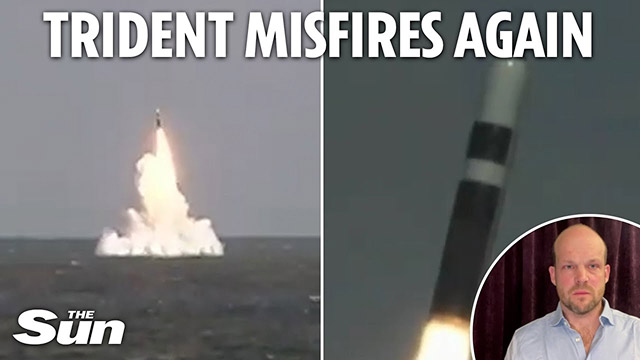
The country’s nuclear-weapons program is in bad shape, yet it is one of only two nations actively rearming. What’s it all for? – asks ‘The New Yorker’.
At 2:15 a.m. on January 29th, the United States National Geospatial-Intelligence Agency issued a Hazardous Operations warning for a stretch of ocean from the waters off Port Canaveral, Florida, to some empty waves in the middle of the South Atlantic, about a thousand miles off the coast of Liberia. The operation in question was the firing of a Trident-II D5 ballistic missile, which weighs fifty-eight tons, from H.M.S. Vanguard, one of Britain’s nuclear attack submarines. The Vanguard had recently completed a seven-year, five-hundred-million-pound refurbishment and was there to show that it was ready to go back on patrol. Such tests are called Demonstration and Shakedown Operations (DASOS).
There was some pressure for a good show. During the last British daso, in June, 2016, the Trident, instead of heading farther out to sea, took off in the direction of Florida before self-destructing. For this year’s launch, Grant Shapps, the British Defense Secretary, was on board the Vanguard, as was the First Sea Lord Admiral Ben Key, the head of the Royal Navy. This daso was a damp squib as well. The Sun reported that, after the missile rose into the air from the submerged Vanguard, its boosters did not properly ignite. “It left the submarine but it just went plop, right next to them,” a source told the newspaper. The Trident sank to the bottom of the sea.
Britain’s nuclear weapons have always been an act of misdirection—the assertion of an identity that no one totally believes. During the Second World War, the country’s small but sophisticated atomic-weapons program, known as Tube Alloys, was merged with the Manhattan Project, and Britain sent scientists (including Klaus Fuchs, a Soviet spy) to Los Alamos. In 1946, the U.S. withdrew from nuclear coöperation, leaving the U.K. with the awkward choice of whether to develop a bomb on its own.
In 1958, British and American nuclear coöperation resumed, and in 1962 John F. Kennedy agreed to sell Britain Polaris missiles, which could be launched from Royal Navy submarines. Since Polaris came into service, the U.K. has operated what it calls a Continuous at Sea Deterrent (CASD, pronounced “casdee”).
CASD has never been as vulnerable as it is now. When this year’s failed test became public, Shapps reassured the House of Commons that, over all, the Vanguard’s daso had been a success. “An anomaly did occur,” Shapps acknowledged. “But it was event-specific.” (The gossip among British defense analysts is that the fault was caused by testing equipment, rather than by the underlying technology.) But if nuclear deterrence is mostly about perception, then everyone agreed this was a bad look. “Let’s not pretend. It is very embarrassing,” Admiral Alan West, a former First Sea Lord, told me recently.
It was also, to some extent, foreseen. Everything about Britain’s nuclear-weapons infrastructure — its submarines, missiles, warheads, testing facilities, dockyards, bunkers, an opaque collective known in official documents as “the Defence Nuclear Enterprise” — is aging out. And none of its replacement parts are anything like ready yet. The Vanguard, which fired the faulty missile, has been in service for thirty years — five years longer than it was designed for.
The first of the new ships, H.M.S. Dreadnought, which was originally supposed to come into service this year, is now not expected until the early to mid-twenty-thirties, and no one is holding his breath. For the past two years, the Infrastructure and Projects Authority, which supervises Britain’s biggest public building programs, has given the new submarines’ nuclear core and fuel development (under the charge of Rolls-Royce) a red rating, meaning: “Successful delivery of the project appears to be unachievable.”
No one is sure that the existing submarines can hold out until the new ones come along. Each year, the repairs to the fleet are more time-consuming and expensive than they were before. This, in turn, puts more strain on the boats and crews out below the waves. In March, the Daily Mail reported that H.M.S. Vengeance returned to port after more than six months at sea, the second-longest patrol on record. (In the past, patrols lasted ninety days or so.) While on patrol, bombers stay at a constant depth and move slowly, cut off from the population they defend. They do not transmit messages, which might reveal their location.
Keir Starmer, Corbyn’s successor as Labour leader Britain’s next Prime Minister, is always looking for opportunities to show how serious he is. Starmer’s two big words during the election campaign so far are that Britain is ready for a “change” from the Conservatives and that people should vote for his “changed” Labour Party. Nuclear weapons are an easy way for Starmer to put some distance between himself and Corbyn. In April, he visited a submarine shipyard in Cumbria and described his commitment to the nuclear deterrent as “unshakable, absolute, total.”
In practice, this means nuclear rearmament. In 2021, under Boris Johnson, the U.K. stopped reducing its weapons stockpile and became the world’s only nuclear-armed country apart from China to openly rearm—with a plan to add up to eighty warheads, an increase of some forty per cent, by the mid-twenty-twenties.
Nevertheless, a belief in the need for Britain’s nuclear weapons, however fervent, does not mean that the weapons are in good order.
It is curious that the nation’s nuclear-weapons program — which appears to be simultaneously falling apart and expanding — barely makes it into the conversation. It’s taken for granted, perhaps, that we’ve got to have the bloody Union Jack on top of it. We’re too scared to let it go.
UK’s Trident nuclear-deterrent system misfires during test, missile crashes near launch submarine:
read more in our Telegram-channel https://t.me/The_International_Affairs

 11:05 15.07.2024 •
11:05 15.07.2024 •






















